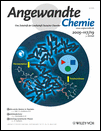Two Faces of a Biomimetic Non-Heme HOFeVO Oxidant: Olefin Epoxidation versus cis-Dihydroxylation†
The bio-inspired catalysis work at the University of Minnesota is supported by the US Department of Energy (grant no. DE-FG02-03ER15455 to L.Q.). We gratefully acknowledge the National Supercomputer Center (Sweden) for generous grants of computer time. We thank Dr. Megumi Fujita for useful discussions.
Graphical Abstract
Zweierlei Reaktivität zeigt eine HOFeVO-Spezies bei der Fe(tpa)-katalysierten Oxidation von Olefinen (tpa=Tris(2-pyridylmethyl)amin). Greift der Oxoligand an einem olefinischen Kohlenstoffatom an, so entsteht das Epoxid, ist es der Hydroxoligand, so wird das cis-Diol gebildet (siehe Schema). Hybrid-Dichtefunktionalrechnungen ergaben vergleichbar hohe Aktivierungsenergien für die beiden Reaktionen.





